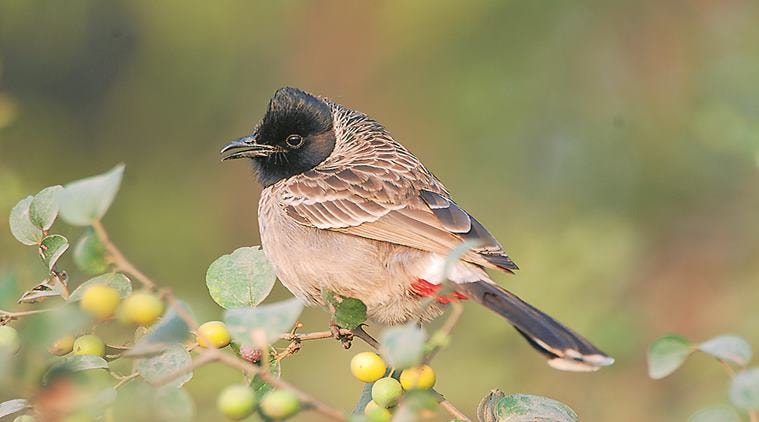
An early morning alarm is not the most popular of sounds, regardless of whether it is a high-pitched electronic beep, a bone-juddering old-fashioned fire-engine bell, or, even a soothing tune getting louder and louder. It’s worse if someone is shaking you awake, or — if an annoying sibling — upending a glass of water on your face.
I’ve been lucky in this respect: for years, I have been awakened by a cheerful, mellifluous call that says, “Hey sleepy-head, wake up and look lively! The sun’s coming up, in case you haven’t noticed.” My personal alarm is a happy-go-lucky red-whiskered bulbul which, at the time of writing, is busy encouraging its babies to go out and seek their fortune in the big bad world. He and his family live in the bougainvillea creeper growing outside my window. And these guys know all about daylight saving time: the fellow will wake me up punctually at dawn, which means, in summer it could be at 5 am, and, in winter, at 7.30 am. Eminently sensible.
He is a slim, lissome bird, a little smaller than a myna, umber brown above, off-white below, with red tufts on white cheeks matched with a red bottom (vent). He sports a jaunty, forward pointing crest and has a “chinstrap” which seems to hold it in place and which makes him look like a cheerful guardsman. (I would love to see the ramrod-stiff guards outside Buckingham Palace sporting these crests instead of wearing those stuffy bearskin busbies!)
For the past several weeks, I’ve watched the bulbuls dive in and out of the bougainvillea creeper from the drawing room; sometimes, there’s a gawky adolescent perched on a twig nearby, desperately fluttering its wings and demanding to be fed, while its parents exasperatedly say “Go feed yourself, now, you big hulk!” By and large, the red-whiskered bulbul is a cheerful, optimistic character which may enter your home if due hospitality is extended. Like most others of their clan (there are around 20 species listed for India) these bulbuls feed on insects, berries and fruit, and there can be great excitement when, for example, bushes full of ripe zizyphus berries are discovered: sometimes the birds get so excited that they literally don’t seem to know whether they’re coming or going, as they fly from one bush to another. This cheerful clan can be found nearly all over India, even in noisy cities and towns.
Their more down-to-earth cousin, the red-vented bulbul is, if anything, more common. Dark coffee brown, with a black head and truncated crest, it sports scaly hackles on the back of its neck — and has a scarlet bottom. Its black tail is white tipped. This guy seems to have imbibed big-city belligerence — he’s pugnacious (and has been kept as a fighting bird) and bold — often driving away his genteel above-mentioned cousin from a choice feeding spot. But he is bit of a duffer when it comes to home security. I once walked past a hedge in a garden (in Palanpur, I think) when an urgent, hysterical cheeping sound broke out. Then I spotted the pair of highly agitated red-vented bulbuls perched nearby, launching brief ineffectual sorties. I knew immediately there must be a nest (with babies) nearby — probably in the hedge. If the birds had just kept quiet, I wouldn’t have had a clue!
Another charming member of this family is the white-eared bulbul, which I personally call the “sunshine bottom bulbul”. Also brown, it has dazzling white cheeks in a black face, a yellow vent, and a truncated crest. Many years ago, a pair nested in the garden hedge, here in Delhi, but I haven’t seen them here since: they prefer drier areas of the country. Up in the mountains, you find the Himalayan bulbul, which is very similar except that it sports a jaunty court-jester’s crest (like the red-whiskered) and has the same cheerful disposition as its cousin and that sunshine bum. They’re common around Himalayan hill-stations, often hopping up close to check if you’re having a good time (and have properly finished your breakfast).
Up in the mountains, too, I once came across a gang of black bulbuls — partying madly and stuffing their faces in some tree which, again, had just yielded a bonanza of berries. They’re sooty black birds with bright red bills and legs and a devilish look in their eyes. Really, it seemed similar to what happens in some pubs over the weekends in this part of the country — with brawls breaking out everywhere and colourful cursing. Alas, there were no bouncers to be seen, so the riotous racket continued unabated.
While, by and large, the clan seems to be faring well, three species have been put on the International Union for Conservation of Nature (IUCN) Red List of Threatened Species. They are the yellow-throated bulbul mainly from south India, (listed as Vulnerable), the grey-headed bulbul from the Western Ghats (Near Threatened) and the rather insipid Nicobar bulbul (Near Threatened), endemic to the Nicobar Islands.
Bulbuls can be a tonic for stressed out city-dwellers. Just check out a pair as they flit around in the foliage, calling cheerfully to one another and you’re sure to feel better and lighter. Ah, but if you could only join them!
(Ranjit Lal is an author, environmentalist and bird watcher)